#alvarezsauridae
Text

Mononykus from Prehistoric Planet!
#myart#artists on tumblr#art#dinosaur#dinosaur art#fanart#paleontology#digital art#dinosaurs#paleoart#prehistoric planet#mononykus#alvarezsauridae
289 notes
·
View notes
Photo

Day 16: Shuvuuia deserti
#Shuvuuia deserti#Shuvuuia#Mononykini#Alvarezsauridae#Theropoda#theropod#paleoart#dinosaur#paleoblr#paleontology#archovember#archovember2022#dinovember#dinovember2022#art#digital art#palaeoblr
39 notes
·
View notes
Text
Dinosaur from newfound species died in a pose that sheds light on evolution of bird behavior | CNN
3 notes
·
View notes
Text
Shuvuuia deserti. I know they probably didn’t have facial discs but I couldn’t help myself. At least it’s better than 90% of reconstructions where the poor lad is only given a thin layer of hair and looks like a naked chicken when it seemed more like an animal who’s silhouette consisted 90% of feathers and 10% flesh and bone.

With Hatsune Miku for scale:
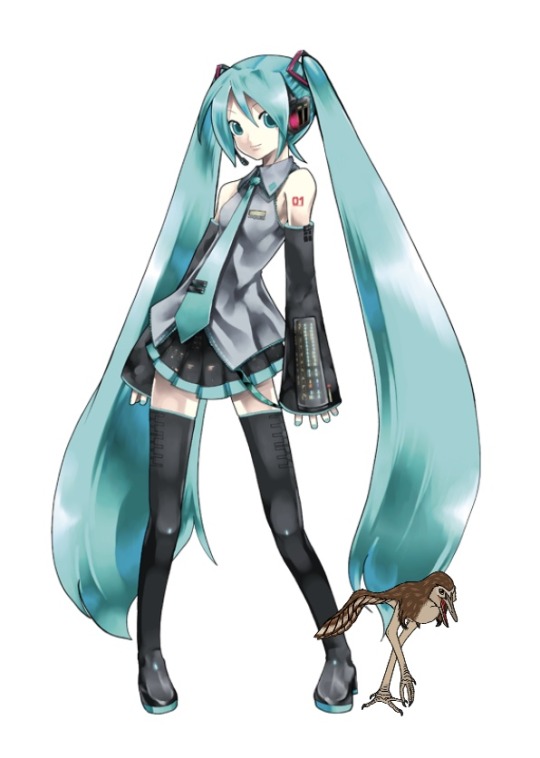
7 notes
·
View notes
Text
Dinofact #30
Shuvuuia, a small, bird-like alvarezsaurid from the late cretaceous, is unique among non-avian theropods, in that it can flex its upper jaw independently of its braincase - something that most other non-avian theropods cannot do.
Source: wikipedia [1], [2]
#dinosaur#dinosaurs#paleontology#shuvuuia#alvarezsaurid#alvarezsauridae#alvarezsaurids#theropod#theropods#theropoda#non-avian theropod#non-avian theropods#prokinesis#cranial kinesis#fun facts#trivia#dinosaur trivia#dinosaur fun facts#23rd#september#2022#september 2022#september 23rd#september 23rd 2022
10 notes
·
View notes
Photo
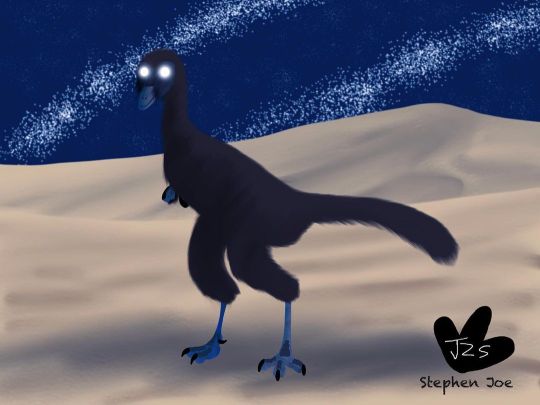
Day 16: Shuvuuia deserti #DjadochtaJuly #procreate #paleoart #artistsoninstagram #myart #shuvuuia #alvarezsauridae #maniraptora #theropoda #dinosauria #dinosaur #feathereddinosaur #notcurnal https://www.instagram.com/p/CgE0VhwLtO9/?igshid=NGJjMDIxMWI=
#djadochtajuly#procreate#paleoart#artistsoninstagram#myart#shuvuuia#alvarezsauridae#maniraptora#theropoda#dinosauria#dinosaur#feathereddinosaur#notcurnal
0 notes
Text
A team of paleontologists and biologists from Hokkaido University, Hokkaido University Museum, North Carolina State University and the Mongolian Academy of Sciences, has uncovered a previously unknown species of dinosaur that appears to have slept in the same position as modern birds.
In their paper published in the open-access journal PLOS ONE, the group describes where the fossil was found, its condition, and the unique position in which the specimen had folded itself before dying.
Until recently, members of the Alvarezsauridae family, a group of small therapods (carnivorous bipedal dinosaurs), were believed to be a kind of flightless bird—now, they are classified as Maniraptoran dinosaurs, a type that is non-avian but is still related to modern birds. In this new study, the researchers found a new species of Alvarezsauridae they have named Jaculinykus yaruui. It translates to "speedy, tiny dragon" and has a lineage with a group that had several bird-like features.
The fossil was found at a dig site in Mongolia's Gobi Desert called the Barun Goyot Formation, embedded in rock in a place called Nemegt. The site has yielded a number of dinosaur fossils over the past several years. The newly found fossil has been dated to approximately 71 million years ago. The team describes it as being in very good condition—it is a nearly complete, 3D preserved fossil.
Continue Reading.
522 notes
·
View notes
Note
Breme or Radox my beloveds!
(Vivosaurs!)

You get.... both!!!!! You know that thing where cats will, like, smack the shit out of something they don't understand until it makes sense? Yeah
Also apparently the dinosaur breme is based on is tentatively placed in alvarezsauridae so that's interesting
80 notes
·
View notes
Text
Bannykus vs Ambopteryx
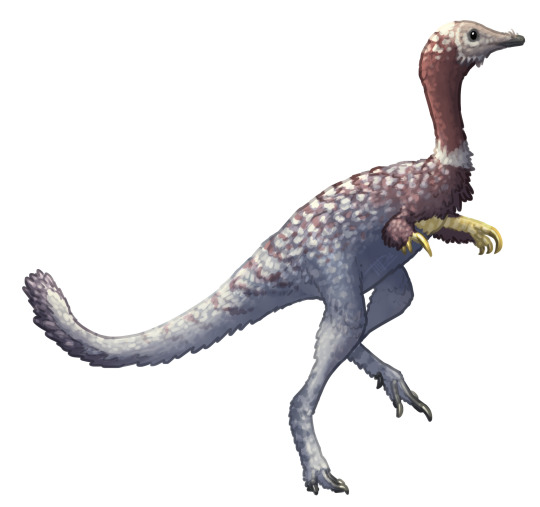

Factfiles:
Bannykus wulatensis

Artwork by @i-draws-dinosaurs, written by @i-draws-dinosaurs
Name meaning: Half claw from Wulatehouqi
Time: 113 to 100 million years ago (Albian stage of the Early Cretaceous)
Location: Bayin-Gobi Formation, Inner Mongolia, China
If there’s one group of dinosaurs that has most recently gained more fame among casual dinosaur fans it’s probably alvarezsauridae, elevated to stardom by the Mononykus that captured everyone’s hearts in Prehistoric Planet. The bizarre group of single-clawed maniraptorans has been studied for a while, but their evolutionary origins have fairly mysterious until recently. How did that whole giant thumb claw thing happen??
Published in 2018 alongside more basal alvarezsaur Xiyunykus, Bannykus helps to fill in a gap in that evolutionary pathway! More specifically, they help to fill in a 70 million year long gap between the primitive Late Jurassic Haplocheirus and the very end of the Cretaceous! Notably, Bannykus has a larger thumb claw that the rest of its claws, but the other fingers are at least partially functional instead of just nubbins. It’s a lot easier to see how the later alvarezsaurids got to where they are from here! Next time you lose your mind over the Mononykus from Prehistoric Planet (which I do at least weekly), say a thank you to the lil guy with slightly less weird hands. Thumbs up to Bannykus!
Ambopteryx longibrachium

Artwork by Gabriel Ugueto, written by @i-draws-dinosaurs
Name meaning: Both wings with long arms
Time: 163 million years ago (Callovian stage of the Middle Jurassic)
Location: Haifanggou Formation, China
Look, evolution has done a lot of weird stuff to dinosaurs. It put penguins underwater, and did whatever the hall mamenchisaurid necks are, and game lambeosaurs a built-in face trumpet. But I would argue there is one group that represents dinosaur evolution at its most unhinged, and that is scansoropterygidae.
Scansoriopterygids were generally considered “weird little tree dinosaurs” in the 2000s, with long fingers to pick grubs out of bark or something. Then Yi qi swept along in 2015 and revealed that those long fingers were actually supporting membranous bat wings. With an extra bony rod (the “styliform element”) sticking out of the wrist to help support it, because well if you’re a dinosaur evolving bat wings why bother being normal about it after that? Although really, the dinosaurs did it first so bats actually have dinosaur wings.
Yi was sensational, but it was also extremely weird and completely unique. Even other scansoriopterygids didn’t have wing membranes, so the whole bat thing was a bit up in the air. Or not up in the air, as the case may be. But then along comes Ambopteryx, published in 2019, packing another set of skin wings, and the vindication of Yi is complete!
Ambopteryx preserves a styliform element and wing membrane, as well as a thick coat of feathers, and honestly out of a whole selection of dinosaurs I think these might be some of the most huggable in the lot. Obviously this whole wing membrane thing didn’t end up working out for them long term, but Ambopteryx is part of an incredible lineage that challenged what we thought was possible for dinosaurs!
DMM Round One Masterpost
#dmm#dinosaur march madness#dinosaurs#paleontology#dmm round one#dmm rising stars#palaeoblr#bracket#march madness#polls#bannykus#ambopteryx
338 notes
·
View notes
Text
Restudy of shoulder motion in the theropod dinosaur Mononykus olecranus (Alvarezsauridae)
Published 5th December 2023
Investigation of the range of motion at the shoulder in Mononykus olecranus is conducted by measuring the angle of the humerous. Results show that Mononykus olecranus was able to tuck its arms in at the sides allowing them to sprawl to orient the palm downward ,enabling a hook-and-pull digging at surfaces to forage for insects.

Experimental setup and Range of humeral motion in Mononykus olecranus

Life reconstruction of Mononykus olecranus foraging for termites in some wood, artwork by Leandra Walters
Source:
9 notes
·
View notes
Text
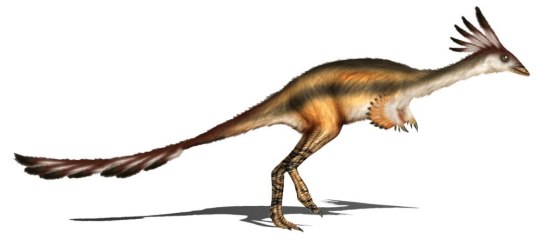
Alvarezsaurus
Альваресзавр (лат. Alvarezsaurus)- монотиповий рід динозаврів-теропод з родини альваресзаврид (Alvarezsauridae) клади манірапторів. Включає єдиний вид — Alvarezsaurus calvoi. Відомий по викопним решткам із відкладень пізньої крейди формації Бахо-де-ла-Карпа в аргентинській провінції Неукен сантонського ярусу (86,3—83,6 млн років). Знайдений аргентинським палеонтологом Хосе Фернандо Бонапарте (José Fernando Bonaparte) і названий на честь історика Грегоріо Альвареса (Don Gregorio…
Повний текст на сайті "Вимерлий світ":
https://extinctworld.in.ua/alvarezsaurus/
#alvarezsaurus#alvarezsaurus calvoi#paleoart#science#argentina#neuquen#dinosaurs#theropod#maniraptora#dinosaur#late cretaceous#south america#cretaceous#extinct#cretaceous period#scientific illustration#art#animals#prehistoric#prehistory#paleontology#extinct animals#палеоарт#палеонтологія#вимерлі тварини#доісторичні тварини#ukraine#україна#тварини#tumblr
20 notes
·
View notes
Photo

Dinovember day 4 - Patagonykus
A pair of patagonykus enjoy a rather calm day.
#Dinovember#Patagonykus#dinosaurs#drawdinovember#dinovember 2018#Alvarezsauridae#Theropoda#Dinosauria#patagonia#cretaceous#dinosaurios#Pyroraptor42#copropost#araucaria#My Drawings#feathered dinosaurs#fluffy dinos#Paleontology#paleontología
44 notes
·
View notes
Photo

I saw the list from @a-dinosaur-a-day today and liked it. (I also miss inktober).
Here’s a proud Patagonykus. Really fan of Alvarezsauridae.
(( I hope it’s accurate enough.))
36 notes
·
View notes
Photo

Daily D&D Monster: Firenewt
One thing that humans are always confused about when speaking to other races is the presence of other sentient species within their genetic family. Whereas all other species of the Homo genus went extinct (either through natural causes or because of us), multiple species of elf, goblin, fairy, dwarf, and giant exist together. This is mainly due to differences in their ecological niche, or geographic distances. Like the firenewts, whom evolved an entirely separate way of life when not in competition with their lizardfolk bretheren. Biologically they're much more suited for their natural habitats in the Gobi desert, being smaller (around the size of a kindergartner) and better able to control their body temperature. Firenewts, unlike lizardfolk, are nomads whose culture is based primarily around the domesticated striders (a larger, docile species of Alvarezsaurid). It's commonly thought that this lifestyle was taught to them by the Mongols, who treated them like their reincarnated brothers-in-arms. Babies are born in the saddle, food is loaded onto carts dragged by the striders, and the firenewts fight with spears mounted on their beasts. Because of their magical temperature regulation, firenewts aren't deterred by fire or high temperatures, only making exceptions when their striders need to cool down. One reason they're categorized as monsters and not a civilized race is that, probably another trait introduced by the Mongols, firenewts prefer to raid human settlements rather than hunt animals, as very few large animals exist in their habitat, and killing a strider for food is considered taboo. Another reason is that they often team up with other monstrous races, helping orcs strip villages in the West of their consumables and gold, and rakshasas in the South, who offer large amounts of gold and magical weapons in trade for dominating villages and valleys.
2 notes
·
View notes
Text
Dinofact #108
Albertonykus is the earliest and smallest known North American alvarezsaurid dinosaur. It measured 1.1 m (3.6 ft) long and weighed only 5 kg (11 lb). Albertonykus is also one of few alvarezsaurid dinosaurs found outside of South America and Asia.
Source: Wikipedia
#dinosaur#dinosaurs#paleontology#albertonykus#north america#north american dinosaurs#alvarezsaurid#alvarezsaurids#alvarezsauridae#alvarezsaurid dinosaur#alvarezsaurid dinosaurs#fun facts#trivia#dinosaur fun facts#dinosaur trivia#23rd#december#2022#december 23rd#december 2022#december 23rd 2022#records
5 notes
·
View notes
Text
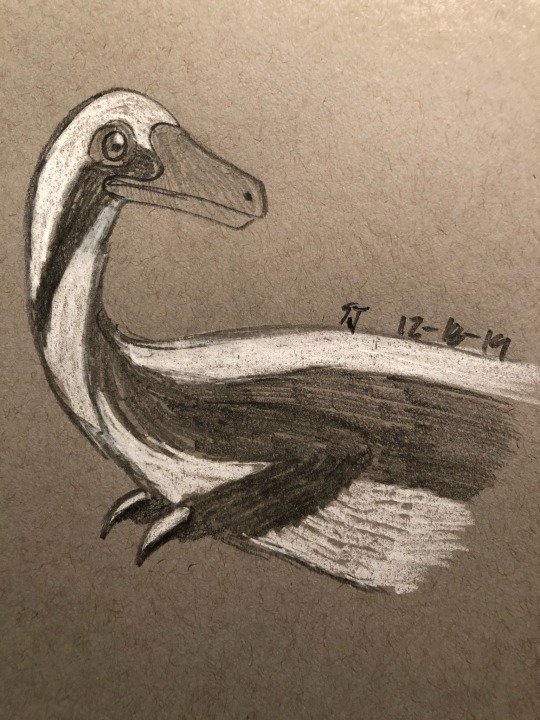
Day 18: Patagonykus.
Which means “The claw of Patagonia.”
#patagonykus#alvarezsauridae#maniraptoria#maniraptoriformes#maniraptoromorpha#coelurosauria#avetheropoda#theropoda#ornithoscelida#dinosauria#paleoart#toned gray sketchbook#sketchbook#my art
2 notes
·
View notes